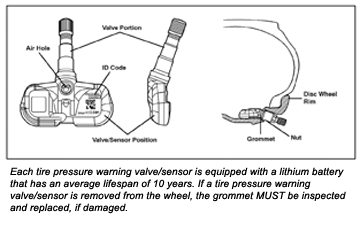 TPMS PROBLEMS
TPMS PROBLEMS
The most common problem with direct TPMS systems is loss of signal from any of the tire pressure sensors. This can happen if the transducer or transponder fails, or the sensor’s battery goes dead. Most use a long-life lithium battery with a life expectancy of 5 to 10 years, but they won’t last forever. Consequently, the likelihood of sensor failure goes up with the age of the vehicle.
Note: If a TPMS warning light is blinking, it usually means there is a fault in the system.
In theory, the tires are supposed to wear out before the sensors go dead. Most manufacturers recommend replacing the sensors when the tires are replaced — which isn’t going to sit well with many motorists because some sensors can cost as much as $200 each to replace! And some of these sensors are “dealer-only” parts that are not yet available in the aftermarket.
It’s illegal to disable the TPMS low-pressure warning light. There is no law that says all of the sensors have to work, or that the system has to be fixed if it’s not working properly. But the riskiest thing any shop could do from a liability standpoint would be to disable a TPMS system for a customer who doesn’t want to pay for new sensors.
Installing aftermarket wheels and/or tires may also create problems with the factory TPMS. Some pressure sensors won’t fit the holes in aftermarket wheels. There are quite a few different configurations for the valve stems and seals. Depending on the wheel, it may not be possible to reuse the original sensors in an aftermarket wheel. You may even have difficulty finding an aftermarket sensor that will properly fit the hole and seal. Federal law does not require aftermarket wheels and tires to work with the TPMS (though this may change). But you can’t tamper with the warning light, and not many customers would want to drive around with a low tire warning on all the time.
REPLACING SENSORS
Removing a tire pressure sensor is not difficult because the sensor is attached to the valve stem. When you remove the nut that holds the valve stem, the sensor will drop down inside the tire. This should be done after breaking the tire bead from the rim, in case you have to hold the sensor so it doesn’t turn while removing the stem nut.
If a tire is being patched or serviced, and the sensor is still good and will be reused, handle it with care. A sensor can be easily damaged if you drop it on a concrete floor, or if you over-tighten the stem nut when you put it back in.
You do not have to remove the sensor when changing a tire, but you must be careful not to damage the sensor by running the tire changer bead breaker or dismounting tool into it, or dragging the tire bead across the sensor as the tire is removed or mounted on the wheel.
Here’s another tip: When letting the air out of a tire, don’t remove the core from the valve stem. Just depress the core. Why? Because the cores on some sensors don’t come out very well, if at all. If you break it, you bought it.
To reduce the risk of damaging the sensor when dismounting a tire, position the wheel on the tire machine so the valve stem is 180 degrees across from the bead breaker.
If a sensor is removed for any reason, or is being replaced, the seal at the base of the valve stem should always be replaced with a new one to ensure a leak-free seal. A new stem nut should also be used, and the nut must be carefully torqued to specifications using a mini-torque wrench that reads inch pounds or has a scale of 1 to 10 Nm. The nuts typically require very little torque, usually somewhere between 35 and 80 inch-pounds (4 to 9 Nm). Always look up the recommended torque value for the vehicle because the sensors will vary.
Over-tighten the nut and you risk breaking the valve stem. Under-tighten the nut and the valve may leak. Most valve stem-mounted pressure sensors require a special nickel-plated core. Do not use an ordinary brass valve core because it can corrode. Install the valve core carefully so as not to damage the sensor. Use a special torque wrench designed for installing valve cores, and tighten the core to 1.5 to 3.5 inch pounds. The tire can now be inflated to the recommended pressure and balanced as usual.








